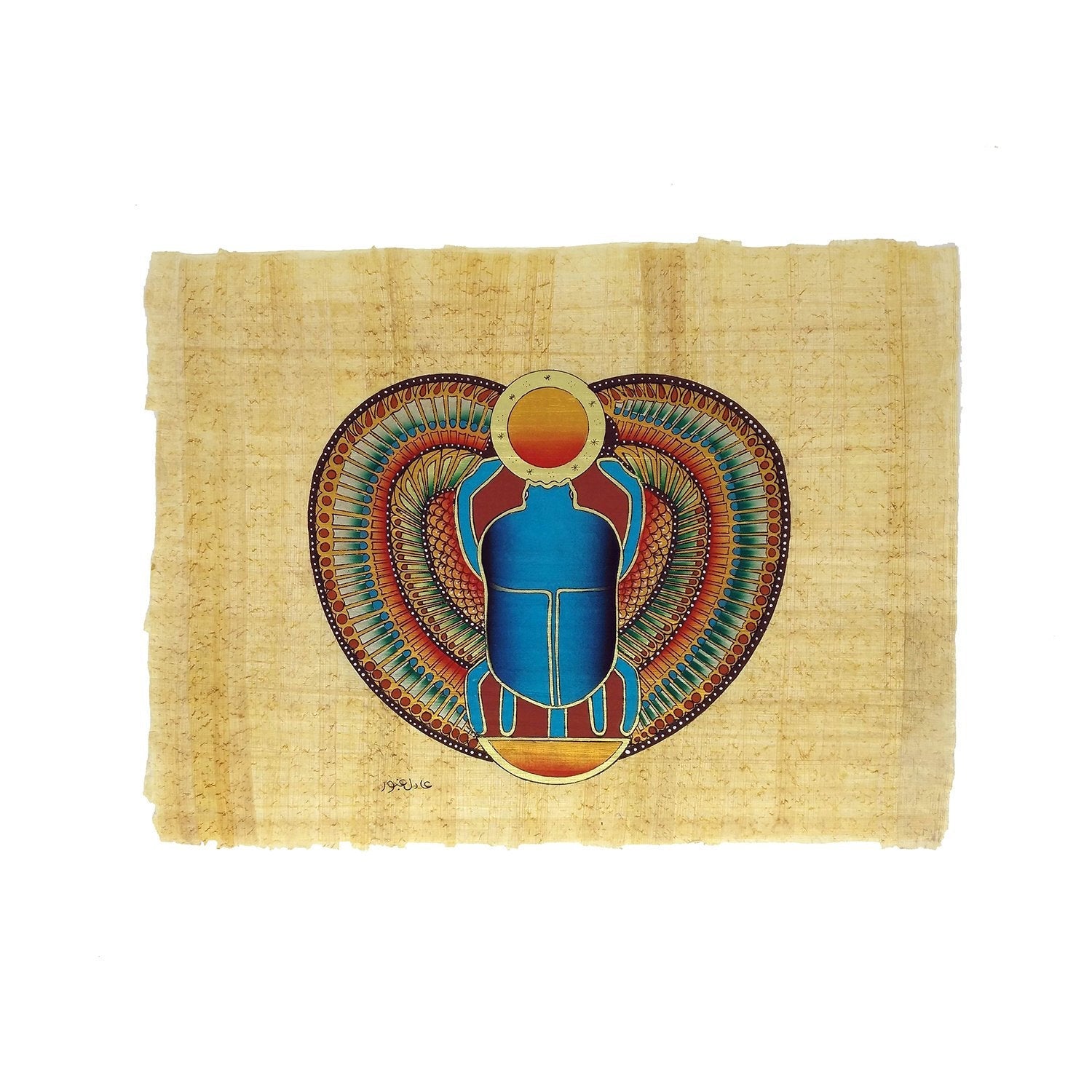
Ankh Ancient Egyptian Papyrus Painting Ancient egypt art, Ancient
1. Ankh The ankh provided the key to the gates of death and what lay beyond. The ankh was the sign of life that indicated the power to give or take away life, and could not be carried by ordinary Egyptians. The original meaning of the "ankh" is still under debate. It has been suggested it was a sandal-strap or a magic knot.

Papyrus with Image of Egypt Gods, Ankh and Scarab Flat Style Stock
The tomb of Ramose and Hatnofer was found intact by archaeologists at Sheikh Abd el-Qurna, in Thebes. The scarab is today on display at the Metropolitan Museum of Art This detail scene from the Papyrus of Hunefer (ca. 1375 B.C.) shows Hunefer's heart being weighed on the scale of Maat against the feather of truth, by the jackal-headed Anubis.

Lovely Egyptian Scarab Papyrus Handpainted and Framed. Etsy New Zealand
symbolism scarab, in ancient Egyptian religion, important symbol in the form of the dung beetle ( Scarabaeus sacer ), which lays its eggs in dung balls fashioned through rolling.

Scarab Ancient Egyptian Papyrus Painting Arkan Gallery
The Scarab Papyrus Ankh is a symbolic Egyptian artifact representing life and protection, featuring a scarab beetle on a papyrus scroll with an ankh. This ancient Egyptian talisman is believed to bring good luck, health, and eternal life.
Scarab with Papyrus Motif Middle Kingdom The Metropolitan Museum of Art
I was pretty sure that there was a group of Egyptian words but fixated on PAPYRUS being one of them to a (quadruple) fault. That's all there is to it for today's Connections clues and answers.

Ankh Ancient Egyptian Papyrus Painting Arkan Gallery
The majority of design scarabs of the late Middle Kingdom (late Dynasty 12-Dynasty 13, ca. 1850 -1640 B.C.) are decorated with symmetric compositions of hieroglyphs and/or scrolls. These signs are not meant to form words but are chosen for their positive, protective meaning.

Scarab Ancient Egyptian Papyrus Painting Ancient egyptian art
Agroittica Lombarda Group in northern Italy produces 15% of the world's caviar. The group is based in the Lombardy region and is split into two companies: Ars Italica Caviar, which farms sturgeons near the city of Cassolnovo, and Calvisius Caviar, based in Calvisano, where the two companies also share the extraction facility. In total, both farms stretch over 250 acres of land and breed seven.

Handpainted Sacred Winged Scarab With Sun Disc Papyrus 30x40cm Son
Scarab Tjet Crook & Flail Shen Udjat Eye Sesen Ben-Ben Symbols in a largely illiterate society serve the vital purpose of relaying the most important values of the culture to the people generation after generation, and so it was in ancient Egypt.

Ancient Egyptian Scarab Beetle Symbol of Rebirth and Rejuvenation, 8.
Surrounded by the rising foothills of the Alps, Lombardy is a region rich in culture, cuisine and castles. Famed for the Duomo of Milan, Lake Como and the Livigno ski resort, this enclave of northern Italy rarely fails to impress - whatever the season. Once you've gotten over the jaw-dropping views of the Alps, you'll realise that the Lombardy region has much more than just spectacular.

Scarab Ancient Egyptian Papyrus Painting Ancient egyptian artwork
Representing transformation, immortality and resurrection, the iconic scarab is actually a type of dung beetle associated with the gods. Why? The beetle lays its eggs in a ball of dung, which provides its newborns with nourishment once they hatch. The story of the dung beetle was thought to symbolise the way life comes from death.

Egypt, Papyrus Depicting the Sacred Scarab, Eighteenth Dynasty Giclee
The ankh is a hieroglyphic good luck charm, the scarab beetle was a symbol of great strength and the Wedjat or Horus eye had the power to protect and heal. The Ankh - a symbol of good luck The Egyptian hieroglyph of the ankh is one of the best known good luck charms. In Ancient Egypt the hieroglyph 'ankh' meant 'to live'.

Scarab on Papyrus Insect art, Scarab, Found art
The Scarab is flanked most immediately by two columns which each feature a prominent Ankh symbol (in dark blue) and immediately above each Ankh for good measure is a Djed column (in light blue, with alternating red and blue segments in the "spinal" columns at the top of each Djed).

Scarab Ancient Egyptian Papyrus Painting Arkan Gallery
of the god Khepri…. - Papyrus of Nesiamsu (Ptolemaic Period) By far the most important amulet in ancient Egypt was the scarab, symbolically as sacred to the Egyptians as the cross is to Christians. Scarabs were already known in the Old Kingdom, and in the First Intermediate Period the undersides were decorated.

Premium Vector Egyptian papyrus with pharaoh element ankh scarab sun
1. Playground Fixtures: Sandbox, Seesaw, Slide, Swing 2. Influence: Clout, Pull, Sway, Weight 3. Egyptian Symbols: Ankh, Crook, Eye, Scarab 4. Fonts: Courier, Impact, Papyrus, Times

Scarab Ancient Egyptian Papyrus Painting Ancient egyptian artwork
The Ankh is one of the most recognizable symbols from ancient Egypt, known as "the key of life" or "cross of life" and dated to the Early Dynastic Period (c. 3150 - 2613 BCE). It is a cross with a loop at the top sometimes ornamented with symbols or decorative flourishes but usually just a plain gold cross.. It is an Egyptian hieroglyphic symbol for "life" or "breath of life" (`nh = ankh) and.

an image of a bug on a piece of cloth that has been embroidered onto it
Scarab depicting a three-stem papyrus plant flanked by "ankh" signs. Egypt. New Kingdom, Early 18th Dynasty. Glazed composition. L: 1.5; W: 1 cm. Harry Stern Collection, bequest of Kurt Stern, London. Accession number: 76.31.4308. Archaeology/Egyptian Archaeology.